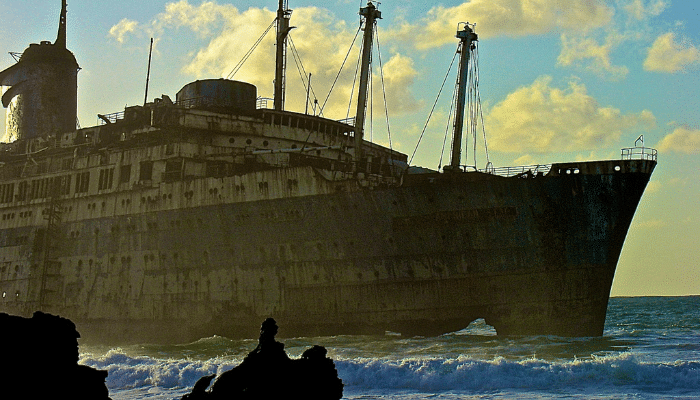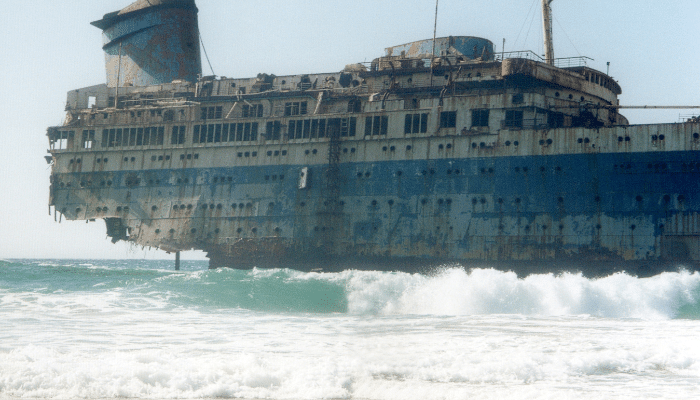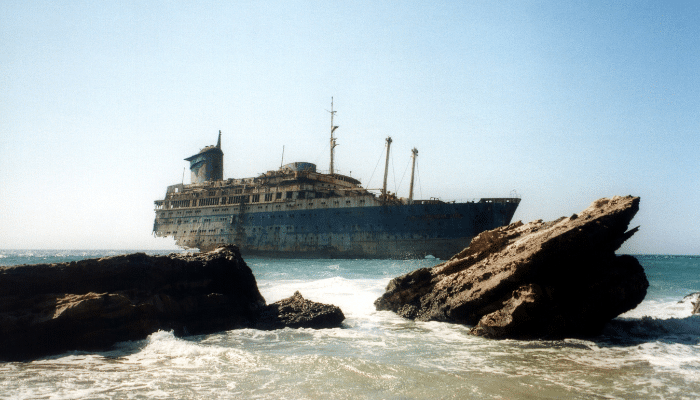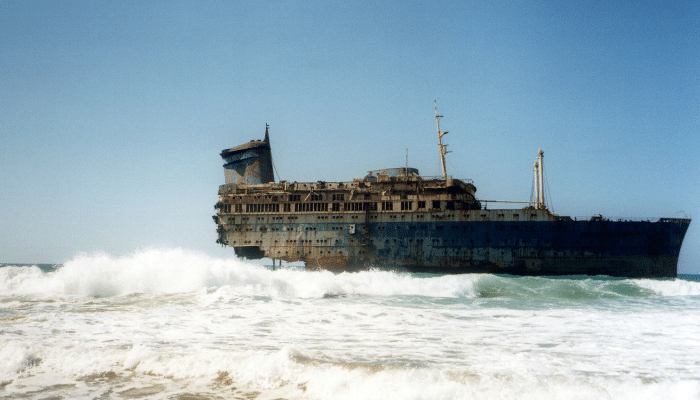10 Interesting SS American Star Facts
When we think of tragedies at sea, we are often reminded of the Titanic or other significant ships in history, such as the RMS Lusitania, which sank in twenty minutes and pulled the U.S. into the First World War.
These ships have also been a subject of popular culture, especially movies that have made them famous and their stories known to people worldwide.
However, what about those ships that met a similar fate but never got the same popularity as the Titanic or the Lusitania and others?
This article reveals 10 interesting facts about one such ship called the S.S. American Star.
A Brief About the S.S. American Star
S.S. American Star was an ocean liner and cruise ship constructed in the U.S., launched in 1939 and entered service the following year.
It was made for the United States Lines, and renowned Naval Architect William Francis Gibbs designed it. The ship was renamed at least 9 times in its 50 years of service, which saw many ups and downs.

It even served the country by carrying troops; however, its fate was miserable. In 1994, the ship was wrecked in the Canary Islands, slowly deteriorating until it completely collapsed into the sea. The ship is not visible anymore on the surface of the ocean and has turned into an artificial reef.
1. One of the few liners of its time to be designed by Women
Newport News Shipbuilding and Dry Dock Company laid down this ship on August 22, 1938, in Newport News, Virginia.
It was 220 m long and 28 m wide with a 10 m draft and 11 decks. It had a gross tonnage of 26 454 tonnes and a displacement of 21,079 tonnes.
S.S. American Star is special since it is one of the few ocean liners of its time whose interiors were designed by women- the New York Firm Smyth, Urquhart & Dorothy Marckwald, who gave her a contemporary and informal look using stainless steel, ceramics and modern pieces, unlike the liners of its time, which boasted an ornate decor.
Launched in 1939, it was sponsored by the then U.S. President Franklin D. Roosevelt’s wife, Eleanor Roosevelt, since her cousin was among the founders of the United States Lines.
2. Became a troop ship for the U.S. Navy during World War II
SS America Star entered service as the flagship of the United States Lines on August 10, 1940. It could accommodate 543 people in the cabin class, 418 in the tourist class, 241 in the Third Class, and 643 crew members.
It had low funnels that gave her a modern and streamlined look, but soon, her funnels’ height was increased by 16 ft as soot was deposited on its decks.
Tensions had begun to rise in Europe with the advent of World War II, in which the U.S. still chose a neutral stance. For protection, the ship’s name, United States Lines and 2 American Flags were painted on both sides of the hull.
As a precaution, the ship sailed illuminated at night and did not ply on its North Atlantic Service Route but sailed in safer regions for some time. In 1941, it was equipped with degaussing cable to offer protection from the naval mines.
On May 28 1941, the U.S. Navy called the S.S. American Star to enter Naval Service as a troop ship. S.S. American Star was at Saint Thomas, US Virgin Islands, when it was ordered to come to Newport News.
3. Carried the largest number of troops during World War II
After the U.S. Navy acquired the ship for transporting troops, it was renamed USS West Point (AP-23). It was converted and fitted with essential equipment and was commissioned into naval service with Frank H. Kelley Jr as its Captain on June 15 1941.
The ship was stripped of its beautiful decor and furnishings and was endowed with life-rafts, bunks, and anti-aircraft weapons, with its windows covered and exterior painted a dull grey. The ocean liner, which could carry around 1200 people, would now accommodate about 7678 troops.
The ship also transported Coast Guard supplies, consular staff, and their families. She was also a part of naval exercises off the Virginia Capes in August 1941 with USS Wakefield and USS Mount Vernon.

It also participated in several naval missions until the war ended in 1945. These included bringing American soldiers back home after Germany surrendered.
In its service years, it accommodated more than 350,000 troops, the largest total for any U.S. Navy troop ship in service during the Second World War. In one of its voyages in 1944, it carried about 9300 people. Apart from troops, it also carried U.N. Officials, civilians, children, Red Cross workers etc.
For its service, the S.S. American Star, then called the U.S. West Point, was awarded several awards and medals like the World War II Victory Medal, American Defense Service Medal, etc.
4. Advent of its Glory Years – Renamed S.S. America
After the war ended, the ship was renamed S.S. America, and it sailed on the New York–Le Havre–Bremerhaven–Cobh Route, which was delayed during the war years.
Many considered her the most beautiful ocean liner to fly the American Flag, given her role in the Navy during the War. She was small yet more graceful than other ships, including her fleet mate, the USS United States, which debuted in 1952.
S.S. America continued to ply on the US-Europe route from 1955 till 1960, but it also went to tropical ports in the Caribbean and the Bahamas. It went on 14 trans-Atlantic journeys in 1962 and 8 the following year.
5. Underwent extensive refits after being sold to Chandris Group & named S.S. Australis
A new market opened with rising immigration from Europe to Australia, and in 1964, the Chandris Cruise Line bought the 24-year-old S.S. America to tap into this gap.
The ship was now named S.S. Australis and was refitted with an additional 350 cabins; many existing ones were equipped with extra berths. Hence, its passenger capacity rose from 1200 to 2258.
On its first voyage, it sailed from Southampton in 1965 to Australia and New Zealand. After that, it sailed regularly from Southampton and also Rotterdam.
It also met with some minor accidents. In 1970, a fire broke out in its galley, but it was extinguished the next day, although its next trip was delayed due to maintenance problems.
In 1974, the vessel collided with the Australian Aircraft Carrier HMAS Melbourne in Sydney Harbour. Although both vessels suffered minor damages, there were no deaths or injuries to those onboard.
S.S. Australis was the last liner offering regular service to Australia and New Zealand until its last journey in 1977. She then headed to Auckland, where she was laid up at Timaru the same year.
6. Sold to Venture Cruise Lines and renamed America to tap on its American Heritage
After the layup, Australis was bought by Venture Cruise Lines and her name was changed to S.S. America, though it was registered as a Greek Ship. Her hull was now dark blue, and funnels were painted blue and red.
The ship set sail in 1978 without complete repairs and refits. It was not in good condition and had soiled linen, trash and old mattresses, accompanied by foul smells from the kitchen and plumbing sounds. Water leaked onto the decks from the overhead pipes. Public rooms were not painted well either.

The ship was overbooked; however, given its condition, the passengers were unhappy and forced the captain to return to New York when it had barely reached the Statue of Liberty. 960 Guests departed the ship, and another 200 left the next day through a tender at Staten Island.
It left for a 5-day trip to Nova Scotia in 1978, and when she arrived, she was met with 2.5 million U.S. dollars in claims from its guests. Also, all its future sailings were cancelled, and it was impounded for not paying its debts. Finally, the U.S. District Court ordered the auction of the vessel.
7. Repurchased by Chandris Lines and renamed Italis
SS American Star was again bought and renamed by Chandris Lines, who decided to give it a new appearance. Her forward funnel was removed, and it was decided to provide her with a streamlined superstructure above the bridge; however, it never ultimately happened.
Italis operated as a hotel ship in 1979 after being chartered for the Organisation of African Unity Conference in Monrovia, Liberia. Then, it carried out three cruises from Genoa to many places in the Mediterranean. After these cruises, it was laid up in Piraeus, Greece.
8. Exchanged hands swiftly, first sold to Intercommerce and then Silver Moon Ferries
In 1980, the ship was sold to Intercommerce Corporation and named Noga. They wanted to convert it to a prison ship and anchor it in Beirut, but this never happened.
Again, the ship was resold in 1984 to Silver Moon Ferries and renamed Alferdoss, which translates to paradise in Arabic. The new owners wanted to make it a floating luxury hotel in Tripoli, Lebanon, but the Civil War shattered that dream.
A bilge pipe burst and flooded the engine room and crew’s quarters. The ship started listing. Hence, the starboard anchor was raised and the port anchor cut. It was beached to prevent it from sinking. After getting repaired, it was brought back.
Silver Moon Ferries sold the ship for scrapping for 2 million dollars in 1989. The scrappers deposited 1 million dollars and began work. However, after its lifeboats were demolished and some more work done, the scrapper defaulted on payments, so it was not completely torn apart and remained in this condition until 1993.
9. Sold to a Thailand Company and named S.S. American Star
The ship was sold to a company in 1992 that wanted to make it a 5-star floating hotel off Phuket in Thailand. Drydocking showed that although the vessel suffered neglect for many years, its hull was in good condition.
In 1993, it was renamed American Star, and it underwent maintenance with the removal of the propellors and the painting of funnels and the bridge. It was not allowed to cross the Suez Canal, given its age. Hence, it went around the Cape of Good Hope to get to Thailand.

It left Greece under tow in 1993 but returned due to bad weather. When it set sail for the second time, it was caught in a thunderstorm in the Atlantic, which broke its tow lines. Although attempts were made to reattach them, they were unsuccessful, and its crew was saved by a helicopter.
The vessel was left adrift at 6:15 am on January 18 1994. Ultimately, it ran aground on the rocky shores of Playa de Garvey, off the western coast of Fuerteventura in the Canary Islands.
10. Ran Aground; however, conditions of beaching made salvage impossible
It was impossible to conduct the salvage operations, and within two days, the strong waves broke the vessel into two, and it was declared a total loss in 1994. Its stern section collapsed completely and sank in 1996, while its bow section remained intact for a decade.
The ship became the biggest story on Fuerteventura Island, and just in 2 days, locals gathered around the wreck and pillaged it for anything and everything they could find.
As years passed, the ship became popular on the internet, and people visited it to take pictures and document its slow deterioration at the hands of natural forces.
In 2019, underwater footage of its debris field showed that its hull and superstructure had disintegrated, though pieces could be seen scattered in the sand. Anchor chains and boiler were still intact, along with the detached funnel, and the wreck site had become an artificial reef brimming with marine life.
The ship was shown in a 1999 German Documentary that took viewers inside its interiors and exteriors through a virtual tour.
You might also like to read-
- 15 Important Red Sea Facts You Must Know
- 10 Facts About The Gulf Of Gabes
- 10 Smallest Aircraft Carriers in the World
- Difference Between Gulf And Bay
- 10 Major Sea Routes of the World
Disclaimer :
The information contained in this website is for general information purposes only. While we endeavour to keep the information up to date and correct, we make no representations or warranties of any kind, express or implied, about the completeness, accuracy, reliability, suitability or availability with respect to the website or the information, products, services, or related graphics contained on the website for any purpose. Any reliance you place on such information is therefore strictly at your own risk.
In no event will we be liable for any loss or damage including without limitation, indirect or consequential loss or damage, or any loss or damage whatsoever arising from loss of data or profits arising out of, or in connection with, the use of this website.
Do you have info to share with us ? Suggest a correction
Disclaimer :
The information contained in this website is for general information purposes only. While we endeavour to keep the information up to date and correct, we make no representations or warranties of any kind, express or implied, about the completeness, accuracy, reliability, suitability or availability with respect to the website or the information, products, services, or related graphics contained on the website for any purpose. Any reliance you place on such information is therefore strictly at your own risk.
In no event will we be liable for any loss or damage including without limitation, indirect or consequential loss or damage, or any loss or damage whatsoever arising from loss of data or profits arising out of, or in connection with, the use of this website.

About Author
Zahra is an alumna of Miranda House, University of Delhi. She is an avid writer, possessing immaculate research and editing skills. Author of several academic papers, she has also worked as a freelance writer, producing many technical, creative and marketing pieces. A true aesthete at heart, she loves books a little more than anything else.
Latest Maritime Knowledge Articles You Would Like:
Subscribe To Our Newsletters
By subscribing, you agree to our Privacy Policy and may receive occasional deal communications; you can unsubscribe anytime.















